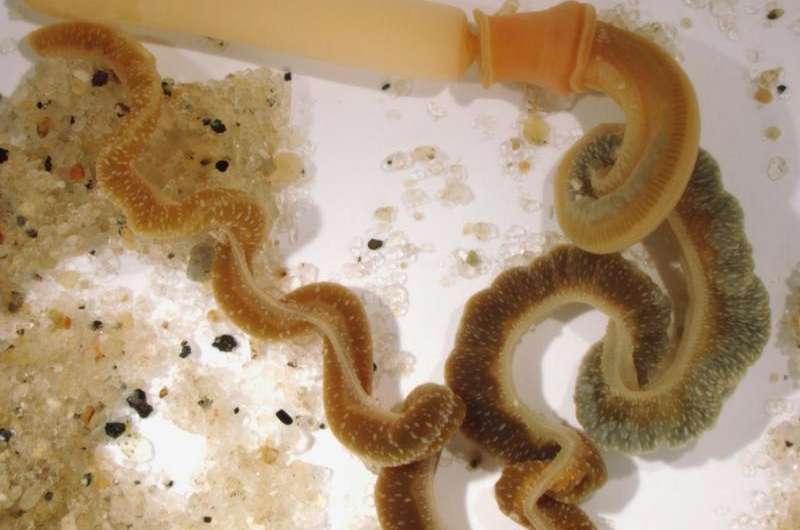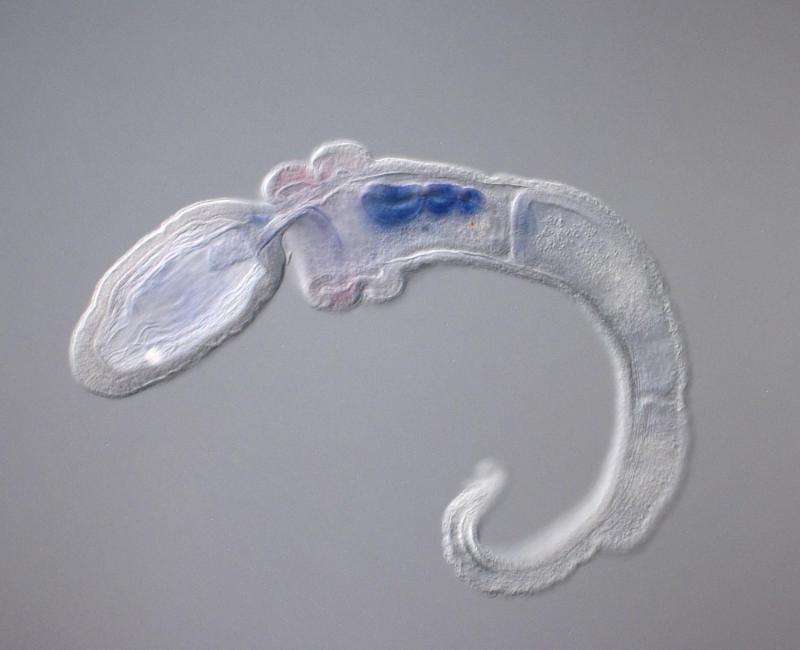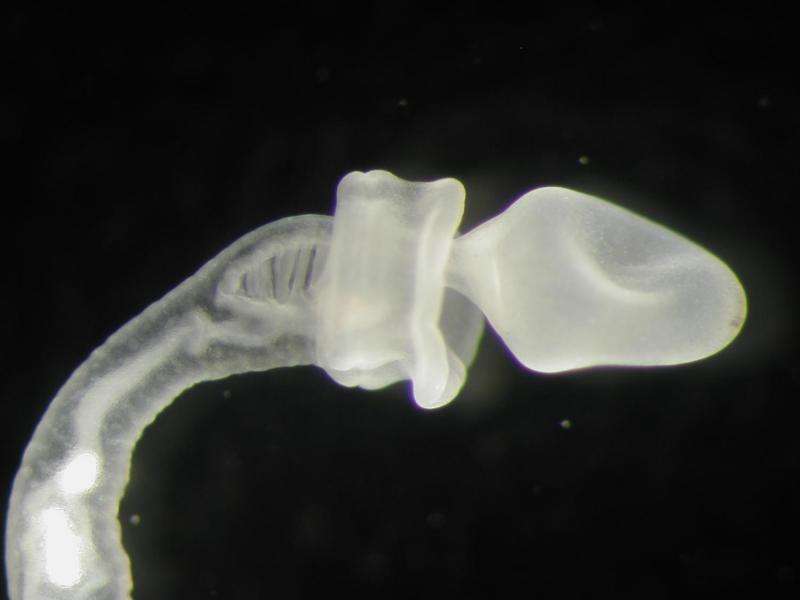Acorn worm genome reveals gill origins of human pharynx (Update)

The newly sequenced genomes of two marine worms are shedding light on the 570 million-year evolution of gills into the pharynx that today gives humans the ability to bite, chew, swallow and speak.
The draft genome sequences of two species of acorn worm, which live in U-shaped burrows in shallow, brackish water, are the first genomes of hemichordates, which retain similarities to the first animals to evolve pharyngeal or "gill" slits. Those ancestors eventually gave rise to chordates: animals with backbones and hollow nerve cords, like humans and other vertebrates.
Since acorn worms and the human lineage diverged 570 million years ago, pharyngeal slits for filtering food evolved into gills for extracting oxygen, and later into today's human upper and lower jaw and pharynx, which encompasses the thyroid gland, tongue, larynx (voice box) and various glands and muscles between the mouth and the throat. Humans and other terrestrial vertebrates actually initiate vestigial gills while embryos, though they disappear quickly and rarely persist in infants.
"The presence of these slits in acorn worms and vertebrates tells us that our last common ancestor also had them, and was likely a filter feeder like acorn worms today," said Daniel Rokhsar, one of the leaders of the sequencing effort and a UC Berkeley professor of molecular and cell biology and of physics. "Acorn worms are marine invertebrates that, despite their decidedly non-vertebrate form, are nevertheless among our closest invertebrate relatives."
"It's an ugly beast," acknowledged John Gerhart, senior author of the report and a professor of the graduate school at UC Berkeley. "Acorn worms look very different from chordates, which makes it especially surprising that they and chordates, like humans, are so similar on the genomic, developmental and cell biological levels."
In fact, about 70 percent of human genes have counterparts in the acorn worms, suggesting that these are ancient genes inherited from the common ancestor.
The research group included scientists from UC Berkeley; the Okinawa Institute of Science and Technology Graduate University in Onna, Okinawa, Japan; Stanford University's Hopkins Marine Station; the Baylor College of Medicine in Texas and the United Kingdom. They published their findings in the Nov. 19 issue of the journal Nature. Rokhsar, who heads OIST's Molecular Genetics Unit as a visiting professor, and Nori Satoh, head of OIST's Marine Genomics Unit, led the project.
Gills a pre-Cambrian innovation

Gerhart has been studying acorn worms for 15 years, specifically an Atlantic species, Saccoglossus kowalevskii, tracking the genes responsible for the development from egg to adult. Ten years ago, he first proposed sequencing its genome.
"I'm interested in the origins of chordates, which, of course, came from non-chordates, and hemichordates like the acorn worm are the closest we have to this lineage," he said. "So it's important to compare the development and genomes of our group, the chordates, with the hemichordates if you want to know what characteristics the common ancestor really had."
It's a small field. Only a handful of labs around the world study acorn worms, which are hard to raise in tanks. They've been largely ignored since biologists first described them in the 1800s, Gerhart said. Several co-authors of the paper lead such labs: Chris Lowe of the Hopkins Marine Station, a former postdoctoral fellow with Gerhart, Marc Kirschner of Harvard University and Nori Satoh in Japan.
One of the peculiarities of the acorn worm is its dozens of pharyngeal slits, which allow it to filter seawater pumped through them to capture nutrients, algae and bacterial prey. These slits evolved into the gill slits of fish and other marine vertebrates, which became specialized to extract oxygen from water and, in the process, lost their ancient filter feeding role.
Gerhart, who has come to appreciate the biology of the worm, said that the unique finger-like 'head' or proboscis of the acorn worm is used to probe the sand for mostly single-celled algae and bacteria, which it then re-suspends in the water to be sucked in and filtered through the gill slits.
"What's so great about having gill slits is the large volumes of water you can put through the animal to collect food; they allow high-throughput filtering and feeding, whereas other animals take one gulp, deal with the food in that one gulp, expel the water out the mouth and take another gulp," he said. "The pharyngeal area of these worms and of all deuterostomes is their most significant shared innovation."
Deuterostomes, which arose in the pre-Cambrian era, comprise chordates, acorn worms - the most ancient deuterostome - and a close relative, the echinoderms, which include starfish and sea urchins. Deuterostomes and another group, the protostomes - 25 phyla encompassing the insects, mollusks and annelids like earthworms - include all bilaterally symmetric animals.

Gene clusters for pharynx
While scientists at Baylor assembled an initial draft sequence of the Saccoglossus genome, Rokhsar teamed up with the Okinawa group to improve the genome sequence and also sequence the whole genome of a tropical Pacific species, Ptychodera flava. The two are distant cousins, separated by 370 million years of evolution.
By comparing the new genome sequences with sequences of many other animals, the team found that clusters of genes on the same chromosome in humans are often found clustered together on the acorn worm genome. Sometimes even the local structure of the cluster is the same, despite the fact that the two genomes diverged more than half a billion years ago, Rokhsar said.
A particularly interesting cluster is a group of six ordered genes that are all implicated in the development of the pharynx and gill slits in both acorn worms and vertebrates. Pharyngeal gill slits - found at least primitively in all deuterostomes - are thought to be an evolutionary innovation that defines the group as a whole, he said.
"We think this is an ancient deuterostome-specific cluster of genes that is involved in patterning the pharynx," Rokhsar said.
Another surprise was that deuterostomes have more than 30 genes that have no counterpart in non-deuterostomes but are similar to genes found in marine algae and bacteria. Several of these genes are involved in modifying the sugars that coat our cells. Either these are very ancient genes that all other animals lost, or they were acquired by "horizontal transfer" from algae and bacteria very early in deuterostome evolution. While bacteria are well known to exchange genes in this manner, it is rare and somewhat controversial to find bacterial-to-animal transfers, Rokhsar said.
"I hope these new sequences will encourage more people to study acorn worms," Gerhart said.
More information: Oleg Simakov et al. Hemichordate genomes and deuterostome origins, Nature (2015). DOI: 10.1038/nature16150
Journal information: Nature
Provided by University of California - Berkeley




















